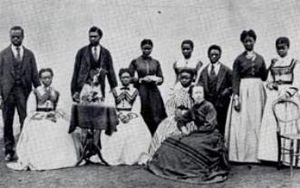Jane Elizabeth Waterston facts for kids
Quick facts for kids
Jane Elizabeth Waterston
|
|
|---|---|
 |
|
| Born | 1843 Inverness, Scotland
|
| Died | 7 December 1932 (aged 88–89) Cape Town, South Africa
|
| Nationality | British |
| Known for | being the first woman physician in Southern Africa |
Dr. Jane Elizabeth Waterston (born 1843, died 1932) was an amazing Scottish teacher. She became the first woman doctor in Southern Africa! She was inspired by the famous explorer David Livingstone. Jane trained to be a doctor and a missionary. However, unfair treatment made her change her path. She decided to work with people in need in South Africa instead.
Contents
Jane Waterston's Life
Early Life and Moving to Africa
Jane Waterston was born in Inverness, Scotland, in 1843. Her father managed the Caledonian Bank there. She grew up to be a teacher. In 1867, she moved to South Africa. She was asked to be the first leader of a new girls' section. This section was part of the Lovedale Missionary Institute. The Lovedale Girls' Institution officially opened on 23 August 1868.
Becoming a Doctor
Jane worked at Lovedale until 1873. Then, she went back to England to study medicine. This was a very difficult goal for a woman at that time. She was inspired by the death of David Livingstone. She also heard that women were finally allowed to become doctors. Jane was lucky to be one of the first women to train at the London School of Medicine for Women. She earned her medical degree in 1880. She also received a special medical license from Ireland.
Working as a Missionary Doctor
After her training, Jane went to the Livingstonia mission. This mission was near Lake Malawi. But Jane was disappointed there. She saw that the male missionaries did not treat the local African people or her very well. They even accused her of looking for a husband at the mission. Jane realised she could do more good elsewhere. So, she left the mission.
Helping People in Cape Town
In 1880, Jane returned to the Lovedale mission for three years. After that, she became a doctor in Cape Town. She started her own private practice. She also lived a social life. She was able to send money back to her family in Scotland. Her family had lost their jobs when the Caledonian bank failed in 1878.
Jane Waterston worked hard to help poor people. She started a group called the "Ladies Branch of the Free Dispensary." It was known for offering "free expenses." But Jane always asked for a small payment. This was to make sure people kept their dignity. She also insisted that mothers who received help should be married. This was true even if their child was born before the marriage. This group helped mothers and trained midwives too. Midwives are people who help women when they are having babies.
Helping in Difficult Times
Jane was also part of a special committee. This committee had six members. It was set up by the British Minister of War. Their job was to look into the conditions in camps where people were kept during a war. Other members of this committee included Millicent Fawcett and Ella Campbell Scarlett. They worked to improve things for the people in these camps.
Recognitions and Legacy
Because of her endless hard work, Jane Waterston was given a special South African name: Noqataka. This means "the mother of activity." In 1925, she became only the second woman to be made a fellow of the Royal College of Physicians of Ireland. This is a very high honour for doctors. In 1929, the University of Cape Town gave her a special Doctor of Laws degree. Jane Waterston passed away in Cape Town in 1932.
Her letters to James Stewart, who led the Lovedale institution, were very important. She wrote to him from 1866 until 1905. These letters were later put together and published as a book in 1983. They tell us a lot about her life and work.


